| Ants |

|
There are many different types of ants found in our homes late in the fall and early in the spring. You need to know the type of ant so that you will know how to manage it in your home and in your landscape. A good guide to help you identify the type of ant you are dealing with is found on the Lancaster County Extension website. The most commonly found ants in our homes includes little black ants, odorous house ants, and carpenter ants. |
|
| Aphids |

|
Aphids commonly attack many landscape ornamentals, trees, shrubs, and vegetable plants. Aphids are very small, 1/8 inch or smaller, soft bodied, green bugs. They have two tailpipes, or cornicles, that stick out from their abdomen. They have a piercing-sucking mouthpart that works like a straw to suck the juices out of our plants. This damage appears on our plants as a stippling appearance to the leaves. Higher populations can lead to curled or puckered leaves and reduce vigor and stunted growth. Some species will even produce galls on our plants. Management can be achieved with a strong spray of water, it will knock them off of the plant and kill the majority of them. Chemical controls are also an option for control of aphids, you can use insecticidal soap, carbaryl, permethrin, pyrethrins, or malathion. |
|
| Bed Bugs |

|
Bed bugs are reddish-brown bugs without wings. They are flat, 3/8-1/4 inches long and they feed on blood, typically of humans, but they can be found on other warm-blooded hosts such as cats, dogs, and birds. They are nocturnal and can be found in many areas around the home. For control, it is best to contact a Pest Control Company that have the right products and training to make sure they are done correctly, safely, and efficiently. For a homeowner with Bed Bugs, vacuum, declutter, and encase your mattress in a mattress cover prior to the professional arriving at your home to help him or her get the best control. |
|
| Bees |

|
Honeybees are the small yellow colored bees that are great pollinators in our environment. Honeybees are not aggressive toward humans unless they feel that their hive or their life is in danger. It is best to avoid using insecticides on flowering plants while they are flowering to avoid harming bees and other pollinators on those plants. There also are a great number of native bees that are mostly solitary, but still carry out important pollination. |
|
| Centipedes |

|
These pests are common outdoors, and migrate indoors to damp areas. They are commonly found in basements and bathrooms. They are usually seen on walls, where they remain motionless for long periods of time |
|
| Cigarette and Drugstore Beetles |
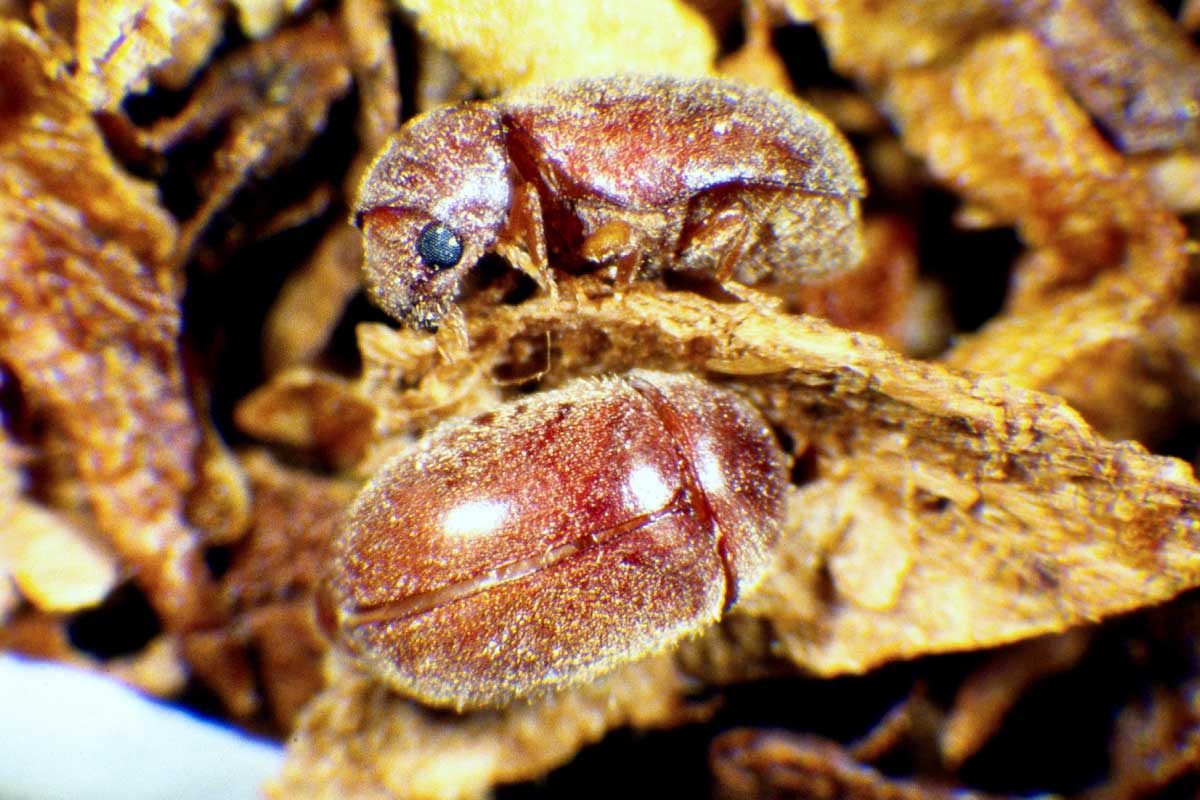
|
Cigarette and drugstore beetles are two beetles that resemble each other. They are dark brown, approximately 1/8 inches long, and have their head tucked under their prothorax making it not visible from above. They feed on pet food, cereal, spices, drugs, tobacco, etc. Do not use chemicals around food products, the best control for any pantry pest would be to store pantry food items in glass or hard plastic containers that have a good seal on them and to not leave them in their original containers that consist of cardboard boxes and plastic bags that the insects can chew into. Also, be sure to keep your cupboards and shelves clean of food debris. |
|
| Cockroaches |

|
There are four species of cockroaches that can be found in our homes in Nebraska, German cockroach, oriental cockroach, brown-banded cockroach, and American cockroach. The German cockroach and the oriental cockroach are the most commonly found in Nebraska homes. They can be found anytime in the year in homes. Management is difficult with cockroaches but it can be accomplished. Use sticky traps to find the population and species present. Inspect all rooms to locate the “hot spots” where most cockroaches are finding. Eliminate their food sources in your home, keep your kitchen very clean and don’t let crumbs, grease, or clutter accumulate anywhere and keep your garbage in tightly sealed containers. Reduce moisture in your home because cockroaches need moisture to survive. Eliminate clutter in your home, these are just more hiding spots for cockroaches. There are many insecticides available to you and to pest control operators. There is a great NebGuide with cockroach information. |
|
| Cutworms |
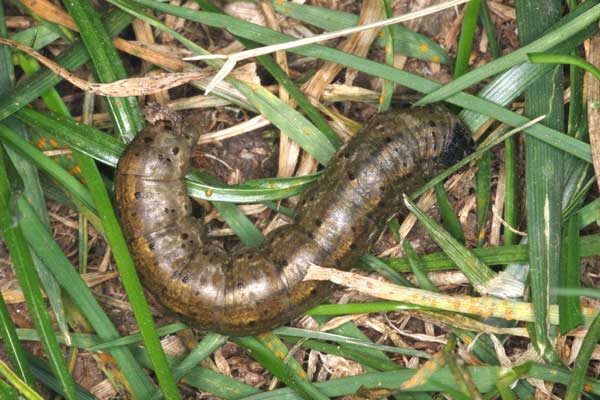
|
Cutworms can be a major pest in both home gardens, as well as row crop production. Cutworms are the larvae, or caterpillar stage of a night-flying moth. |
|
| Dermestid Beetles |

|
There are many different species of dermestid beetles that can infest a home. They are scavengers of animal matter so they commonly feed on hides, wool fibers, dead insects, and dried meats. Closely related species will also feed on grains and products made of grain, which will cause them to be an invader in our stored food items such as flour, cereal, pasta, corn meal, candy, cookies, and much more. Do not use chemicals around food products, the best control for any pantry pest would be to store pantry food items in glass or hard plastic containers that have a good seal on them and to not leave them in their original containers that consist of cardboard boxes and plastic bags that the insects can chew into. Also, be sure to keep your cupboards and shelves clean of food debris. |
|
| Emerald Ash Borer |

|
Emerald Ash Borer (EAB) is an invasive insect pest. It is a pest of ash trees that came to America from China in 2002 on solid wood packing material. It has not been found in Nebraska, as of April 2015. It has been found in Iowa, Missouri, Kansas, and Colorado. It is a metallic green beetle about 13 mm long. The larvae are found feeding in the cambium layer of ash trees which disrupts the flow of water and nutrients throughout the tree. Signs of EAB infestation include top dieback, 1/8 inch D-shaped holes, increased wood pecker damage, epicormic sprouts, and finding the larvae under the bark. Chemical controls are available for high value trees by using trunk injections or soil drenches with imidacloprid, emamectin benzoate, or azadirachtin. Controls are not recommended until the insect is found within 15 miles of the ash tree. Report possible EAB infestations to your local extension office or to the Nebraska Department of Agriculture. |
|
| Flour Beetles |
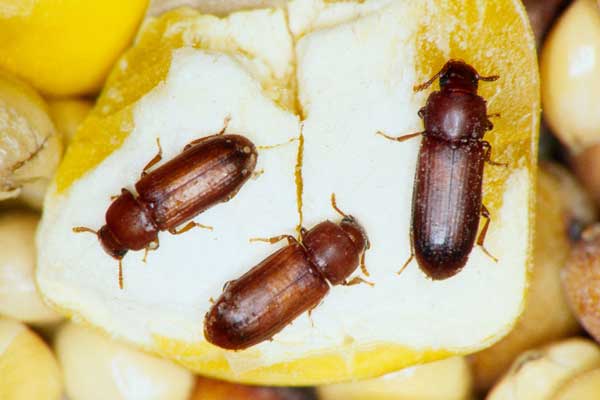
|
In Nebraska, we have two main species of flour beetle, the confused flour beetle and the red flour beetle. They are both 3/16 inches long, reddish-brown beetles that can be found in your pantry food items or crawling along your counter or in your cupboards. They feed on flour, grains, beans, cake mixes, pasta, chocolate, and many more pantry items. Do not use chemicals around food products, the best control for any pantry pest would be to store pantry food items in glass or hard plastic containers that have a good seal on them and to not leave them in their original containers that consist of cardboard boxes and plastic bags that the insects can chew into. Also, be sure to keep your cupboards and shelves clean of food debris. |
|
| Ground Beetles |

|
There are a number of different beetle species that are grouped together under the name of ‘ground beetle.’ Generally they are considered highly beneficial when in their natural habitat. Unfortunately, they occasionally make their way inside homes. |
|
| Indian Meal Moths |
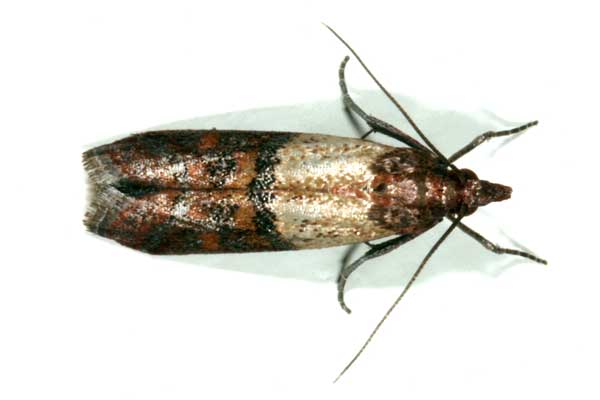
|
Indian meal moth is the ½ inch long, tan colored moth with dark brown wing markings. They can be found flying around your home, mainly in the kitchen. It can be brought into the home in the products you buy at the store, such as dried pet food or bird seed. The larvae, or immature moths, can be found in flour, whole grains, cereal, seeds, etc. and then in the home they can develop into a moth. Do not use chemicals around food products, the best control for any pantry pest would be to store pantry food items in glass or hard plastic containers that have a good seal on them and to not leave them in their original containers that consist of cardboard boxes and plastic bags that the insects can chew into. Also, be sure to keep your cupboards and shelves clean of food debris. |
|
| Millipedes |

|
Millipedes are commonly found in our basements or moving into our homes in the late summer to early fall. Millipedes are not an insect because they have more than 6 legs. They are referred to as wireworms, but a wireworm is actually an immature of a click beetle and they wouldn’t be found in the home. Millipedes are shiny black, worm-like creatures with many legs that coil up when disturbed. They are not harmful to us, they do not bite or spread diseases and they do not reproduce in our homes. Many of them will die once inside the home if the home doesn’t have a high enough level of moisture. The best controls for millipedes would include vacuuming them as you find them in your home and sealing up around doors and windows and all cracks and crevices in your home foundation. Pesticides are minimally effective, but a barrier spray can be applied around your home or buildings where the millipedes are entering for some control. |
|
| Scale |

|
Scale insects can be a problem on trees and shrubs. This insect does not look like a typical insect. It looks like a scaly covering over the branches. They are only mobile as immature scales when they are moving from the protection of their mother to their own location to feed or to a new plant. They are found on many different plants including euonymus, honeylocust, juniper, magnolia, and many more. The plants affected by scale will show signs of wilt, decreased growth, decreased flowering, and yellowing leaves. Management can be achieved through chemical controls but must be done at a certain time of the year. Because of their protective coating, scales are only vulnerable to insecticides when they are in the crawler stage. Tests can be done to determine when scale insects are in the crawler stage. One test is to wrap double-sided stick tape to a branch and watch for the crawlers to appear on the tape when they are moving throughout the tree or shrub. This is the time to apply insecticides such as insecticidal soap or horticultural oils. |
|
| Spiders |

|
While most spiders are considered beneficial, there are a couple in Nebraska that can be dangerous. Make sure you can identify the spider you find, if found indoors. |
|
| Tent Caterpillar |
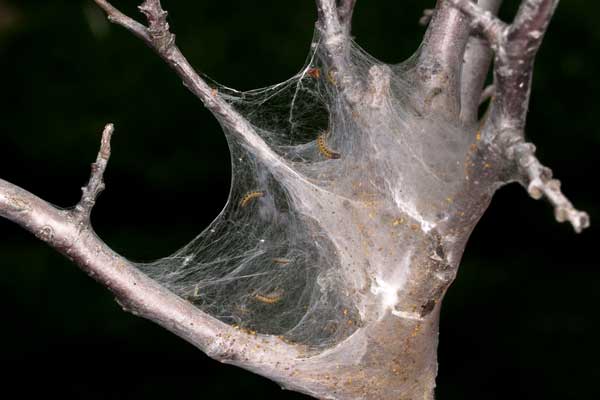
|
Tent caterpillars nests are often seen in spring and early summer, and their nests can be found in the large forked branches in shrubs such plums. |
|
| Termites |

|
Subterranean termites are destructive wood-eating insects and cause home-owners frustration and expense when active nests are found in their houses. |
|


